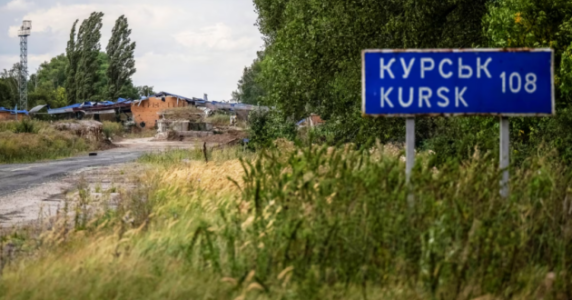Navigation and useful materials
The new Russian history textbook for the graduate 11th school year, which for the first time will be uniform for all Russian schools, is another marker of the rehabilitation of Stalinism and a means of propaganda for the war with Ukraine. The textbook, which examines the period after World War II, glorifies and justifies the totalitarian USSR. A separate large section is dedicated to the legalization and justification of Russia’s attack on Ukraine. Through school and exams, Putinism hopes to reach the youth who does not watch television. Since 1940, the USSR had one single textbook for each year of school education. From this year on, Russia introduces the same policy for years 10 and 11. In a year, uniform textbooks will be published for years 6 through 9. Any other textbooks will be removed from the educational process.
The new textbook contains an entire range of detailed quotes by Stalin. Russian children are meant to graduate with the idea that while “things are not so clear-cut,” this Stalin person was an outstanding figure. The post-war USSR is depicted as a dynamic “golden age”: of course, there were difficulties, but the main thing is that the country became one of the two most influential in the world. The Bolshevik ideology helped to win the war against Hitler, and thus it must be good. The West and the United States are portrayed as aggressors who, to quote the book, “oppress Russia’s national interests.”
According to the propagandists who drew up the textbook, it was the West that started the Cold War. The authors of the textbook do not mention the fact that the Bolshevik terrorist group, which seized power in Russia, proclaimed the goal of world revolution and the communist takeover of the planet, with the destruction of capitalist countries. This is precisely what Moscow was striving for on the eve of World War II. One character of the 1937 Soviet film The Great Citizen says, “Ah, what it would be to go and look at the Soviet Union, around 30–40 republics, after a good War — who knows how good!”
In the Stalinist paradigm, today’s children will be taught, in particular, about the Korean War. The conflict was allegedly provoked by the aggressive actions of the US and their puppets from South Korea. Although, to quote the textbook, “in this situation, North Koreans were the first to launch an attack,” children should have no doubt who is “truly” to blame for the war.
Schoolchildren are offered to look at a propaganda poster from the Korean War times. Comment below: “Officers and sergeants of the South Korean army walked among the rows of prisoners, beat them relentlessly and executed some.”

But there’s more. The textbook offers the children to look at the Korean War from the standpoint of Stalin himself: “America cannot defeat little Korea. We need to be firm in the relations with Americans. Americans are merchants. Every American soldier is a speculator, engaged in buying and selling. The main weapons of Americans are stockings, cigarettes, and other goods for sale. They want to conquer the whole world, but they can’t handle little Korea. No, the Americans don’t know how to fight…”
Indeed, the way the Red Army fought, overwhelming the enemy with the bodies of Russians and other peoples of the empire, without regard for their lives, was not the way normal armies fought. These messages about Korea will be hammered home to Russian children, even when history has already answered the question of which of the two Korean models proved successful.
Khrushchev’s work is described as “chaotic and ill-conceived” because he handed over Crimea to the Ukrainian SSR.
Russian schoolchildren will not learn from their textbook that behind the scenes of propaganda about “friendship of the peoples,” Russian chauvinism grew and flourished. Limited permitted folklore identity attributes of other ethnic groups were not supposed to interfere with the relentless process of Russification in the USSR. Here is another quote from the textbook: “In the 1950s, Stalin personally participated in a discussion on language to talk about the development of the multinational USSR and the formation of a single Soviet people.” This desire to “mix” people, to dilute other nations in the “Russian melting pot,” was what gave rise to the anti-colonial protest.
But the authors of the textbook believe that the USSR did not fall apart due to the decolonization of the peoples conquered by Moscow, but simply failed to reform, and the insidious West took advantage of this. This led to “the biggest geopolitical catastrophe — the collapse of the USSR,” say the authors, quoting Vladimir Putin.
The 1990s are shown as times of impoverishment, although it was in the 80s, during the late USSR period, that consumer goods disappeared from stores. In the 1990s, on the other hand, Russia had the promise of true democracy and free thinking, unlike now.
Among other things, the textbook mentions that Chechnya and Tatarstan declared independence, but “in violation of the Russian constitution.” This is yet another example of hypocrisy from the collapsing empire. If it concerns the real or imaginary territory of the Russian Federation, then separatism is wrong, but with regard to Ukraine, Georgia, and Moldova, separatism is actively encouraged as a liberation movement.
According to the textbook, Chechnya had not a people striving for independence, but Islamic “fundamentalists and terrorists.” Russia, rather than suppress Chechens’ desire for independence, brought “peace,” since a “civil war” started there. As we can see, in Chechnya, as well as in Georgia, Moldova, and Ukraine, the Kremlin’s aggression by a “strange coincidence” always begins with a “civil war,” which the Kremlin “only tries to stop.”
An interesting detail is that the author of the textbook mentions the terrorist attacks in Moscow and other cities of the Russian Federation in the autumn of 1999, cases in which there are well-founded suspicions of the involvement of the Russian special services, only very briefly, with no guess of who is responsible, other than the context. The authors write that “all the responsibility for the operation [in Chechnya] was undertaken by the young PM V. Putin.”
As the result of the war, Chechnya was allegedly “rebuilt” and became one of the “most dynamic regions.” Apparently, they are talking about Kadyrov’s despotic regime, whose “dynamism” causes suffering not only in Chechnya, but in the entire Russia and beyond.
Children are taught that in the recent wars, the US fought with “military and terrorist methods.” This is a clear reflection that Russia is fighting as a terrorist itself, attacking civilians and the economic base of their lives. This is precisely what happened, for example, during the conquest of the Caucasus in the 19th century, when the empire purposefully destroyed crops, livestock and housing, dooming the people who resisted to starvation. We see the continuation of this policy in Stalin’s Holodomor (the Famine of 1932–1933).
As for the war against Ukraine, or “the special military operation,” as it is referred to in Russia, the standard methods of combat propaganda were simply written into the textbook. It contains information about biolaboratories, “the Kyiv regime that bombed the Donbas,” and the genocide of civilians, the origins of the “civil war,” volunteer fighters from the Russian Federation, and finally, Ukraine, which renounced peace and announced plans to develop nuclear weapons. And yet, the authors of the textbook cite the possible accession of Ukraine to NATO as the main reason for the war, which, they say, could lead to a war between Russia and the entire Alliance over Crimea. Thus, pupils should believe that the war was a preventive measure for Russia: “if we weren’t the first to strike…”
One of the paragraphs is very clear in its assessment. It is even called “Ukraine is an ultra-nationalist state.” It teaches children that the Ukrainian military widely uses Nazi symbols. Ukrainians constantly exclaim the slogan to “hang [slur for Russian] on the tree.” Funnily, though, this phrase is a remarkable example of the Russian propaganda investing so much effort into a myth that it started believing it through multiple repetition of the lie.
The textbook also convinces teenagers: “When liberating cities, our fighters find evidence of mass crimes committed by Ukrainian nationalists who abuse civilians and torture prisoners of war.”

The textbook depicts Ukrainians as a nation that does not exist. It was allegedly created by “Austrian intelligence,” which used “Ukrainophilicism.” Hitlerites allegedly also took advantage of this to turn Russians into Ukrainians. Thus, the textbook teaches Russian children Putin’s delusions that Ukrainians are essentially the wrong kind of Russians and they need to be fixed.
“In the 19th century, the nationalist Ukrainophile idea was born for the money of the Austrian intelligence.” This phrase in an actual textbook is a great illustration of the level of today’s Russia.

Children will essentially be taught that Ukrainians were a project of the Austrian General Staff, and now of the US and the West, and this is all directed straight against Russia. Its enemies, the textbook says, “need not a strong Ukraine but a weak Russia.” The textbook says that the Banderovites killed people after WW2. Of course, the fact that the Ukrainian Insurgent Army was fighting for independence from Ukraine’s occupation by the Bolsheviks is never mentioned.
This is a typical method — to call the fighters for Ukraine’s independence against Stalinist criminals “bandits” and “Nazis.” “In 1945-1946 alone, over 10,000 nationalist armed formations, gangs and criminal groups engaging in murder and robbery were terminated.” The lion’s share of them were in the Baltic region (“forest brothers”) and in Western Ukraine (Banderovites)”.
Neostalinism makes another strong appearance in the mention of the 1955 amnesty, when “Ukrainian, Belarusian, Lithuanian, Latvian, Estonian and other nationalists” were liberated from exile. “This ill-conceived decision led to numerous former Nazi sympathizers not only being liberated but engaging in social activity on the wave of the rehabilitation campaign and fight against the one-person cult, some even managing to make a career. Later, it facilitated the emergence and growth of nationalism in the Baltics and western Ukraine,” says the textbook.
The authors write that Western Ukraine imposes “its dialect” on Russian-speaking Ukraine, which cannot even be called the Ukrainian language. Children will also be taught that Ukrainians were forced to abandon their relatives and friends in the Russian Federation. This is how propaganda tries to protect Russians from their Ukrainian acquaintances accusing them of abetting the aggression.

The cover of the textbook fully symbolizes today’s Russia. The picture seems tense. It shows of the aesthetic of mid-20th century sci-fi films, with a large factory or some sort of command centre. Everyone is wearing a uniform and looking somewhere off-camera, with tense, focused faces.
It is pretty telling that in the middle of the image is a rocket, rather a military one than a space exploration unit. It also somewhat looks like a syringe extended to children in an offer to get hooked on propaganda.
The Centre for Strategic Communication and Information Security asked historian Serhii Hromenko to share his impressions.
- How is the attack on Ukraine covered?
- There is no attack on Ukraine in the textbook at all. But there is a history of Russia’s defence against the crimes of the treacherous West. In the very first paragraphs of the section on 2014-2023, the story goes that the West was preparing the same for Russia as Yugoslavia went through, showing the maps of Yugoslavia divided and alleging that Russia took on the challenge. Every time, it only defends itself. It “defended” the Russian-speaking population of Crimea against the horrors of Maidan. Then it “defended” the Donbass residents, who were allegedly all designated as terrorists. When this was not enough (because Ukraine was turned into Anti-Russia and a bridgehead for an attack), Moscow struck first to avoid 1941 repeating itself. This was done to protect the Donbas residents and guarantee the safety of Russian citizens against external threats. Therefore, there is no Russian attack on Ukraine. There is a war with the West on the territory of Ukraine, because the West was going to attack first.
- Is it possible to somehow expose the untruthful and manipulative idea that “the West attacked Russia in Ukraine”?
- I think it’s like talking to flat earthers. We can provide reasoning, show pictures, talk about satellites, but the mindset of people who believe this will not accept any arguments. The situation is the same with Russia’s anti-Western rhetoric — people who are capable of understanding that Russia attacked Ukraine can understand it even from the available facts and official Russian sources. After all, it was Russian troops who entered Kherson, not Ukrainian troops who entered Rostov.
- The textbook mentions Russia’s victory at the Winter Olympics in Sochi with exalted comments: “highest scores,” “confident win.” So, “historians” are not even deterred by the fact that Russia was caught doping at the national level, and its flag is prohibited at the next competition?
- That’s the advantage of having a single textbook — there is no competition. The authors don’t need to think how a certain topic will be covered by other authors, and thus, they can feed anything to children, teachers, and society.
- But children will still inevitably learn about the doping flaud by the Russian authorities?
- Of course, some children will want to know and will know the truth. But many will just accept the official version and never seek an alternative. That’s how it’s written, so it must be true. It is easier psychologically, and conformism in general is very characteristic of humans. Children will memorize the wording for the exam and this information will remain with them.
- The textbook says that “no other army in the world” fought like the Armed Forces of Ukraine did, hiding behind civilians. Isn’t this “too much” — will people still believe it?
- This is a cognitive manipulation called transference. Russians know very well they are the ones with the scorched earth tactic. That is precisely their military glory. Unable to deny the existence of this tactic, they transfer it to the Armed Forces of Ukraine. They blame their own wrongdoings on Ukrainians. We should not even be surprised.
If you have found a spelling error, please, notify us by selecting that text and pressing Ctrl+Enter.


